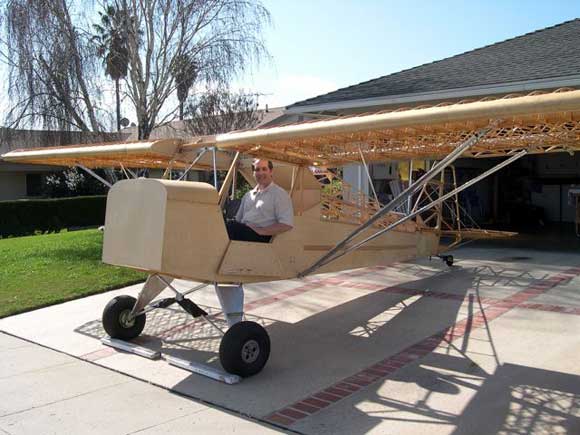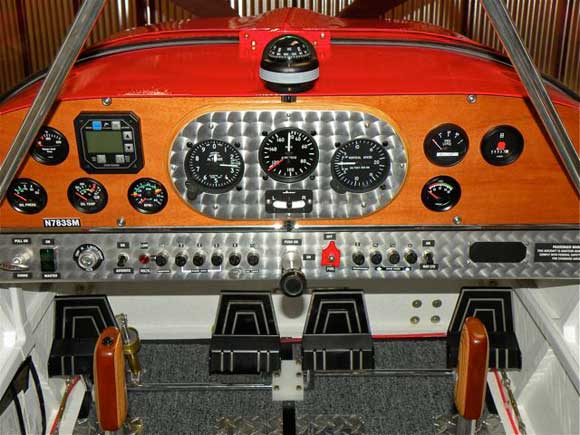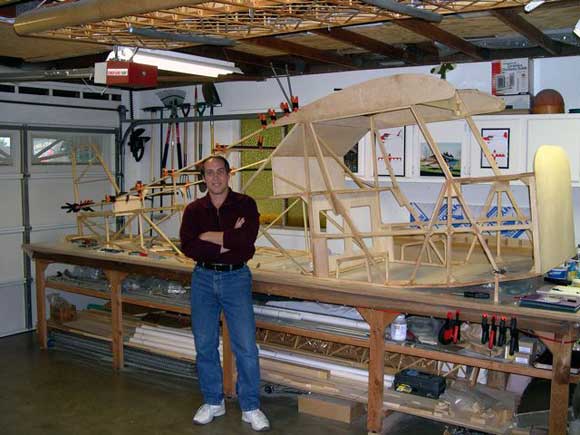Dakota Hawk Aircraft Story
Dakota Hawk The neighbor lady and her young grandson stood admiring my handiwork as it sat jauntily on my driveway. “I just had to show my grandson the big model airplane you’re building; I can’t believe how big it is!” “Well” I replied, “That’s because it’s not a model, I plan on flying it once I’m done.” That’s when I got the look and the inevitable comment that I dreaded hearing, “How can it be a “real” airplane if it’s made of wood?” I was somewhat taken aback by the fact that the question was not uttered by the young boy but rather from his grandmother. Surely someone of her age should have known that wood was the medium of choice from the earliest days of aviation and the decades that followed. For crying out loud, even the famous “Spruce Goose” was on public display for years in Southern California and it was only a short drive away! Well, as I had so many times before when encountered by a neophyte of aviation, I would launch into my condensed history lesson starting with the Wright brother’s early vehicles, the many planes of World War 1 that relied on this material, and then regale my listener with the virtues of plywood as it was used to make legendary craft such as the De Havilland Mosquito and even the early jets. “Why even today, some modern aircraft manufacturers still use wood for wings or spars. Wood has survived the test of time” I announced. The lady was kind enough to nod and interject with comments such as, “Oh, I So there it is, the sad truth. Your average citizen may have known that “Nature’s composite” played a part in the beginning evolution of aircraft designs, but surely with the advent of aluminum, fiberglass and modern day materials wood was relegated to, well, the wood pile. I found out from the very start of my Dakota Hawk project that it would be an uphill battle for acceptance. The area where I live has three general aviation airports along with an EAA chapter, and the place is swarming with homebuilts. Unfortunately there are not too many wood and fabric models to be found. Something about living in California gives the impression that you need something fast and cool looking. You find a lot of Lancairs, Glasairs, Questair Ventures and a wide range of Van’s RV series. I had just received the wing portion of my kit and was attending the local EAA chapter’s annual homebuilder’s fly-in/air show when I spotted their membership stand amongst the crowd. I walked up to the two gentlemen manning the booth, and after exchanging pleasantries I announced my intentions of joining their builders fraternity as I had just taken possession of my own kit plane. “Great, whatcha get?” asked one. “A Fisher Dakota Hawk” I said proudly. It’s a two place wood and fabric, kinda looks like a little Citabria.” “Oh”, replied the other man, like he just discovered he had stepped in something smelly. You should have looked into getting a “real” airplane like an RV”. I was crushed! Of all people, I thought surely these guys would appreciate a man’s desire to build his dream regardless of its make or model. I turned around and walked off. I’m sure upon leaving I was probably mumbling something about not wanting to join an RV club but I don’t recall, I just felt like the only guy in the wedding photo with brown shoes! In all fairness to this particular EAA chapter I have since met several of its members who have watched my project evolve through its various stages and have offered nothing but encouragement and praise. My faith has been renewed! You might ask what inspired me to build a wooden plane. Well to start off, I like wood. The look, the smell, the feel; what’s not to like and best of all, it was everywhere. Growing up on a dairy farm in Iowa gave me plenty of opportunities to build things with wood, and during those long winter months you had to do something with your free time or you would go crazy. Give me three wooden slats from the snow fence in the cow lot, a handful of roofing nails, and I could whip out a Tommy gun in no time. Then came the day in 1970 when I was strolling along the magazine rack in the junior high school library and spied a Popular Science magazine. On the cover was a man flying a small single seat aircraft called the “Volksplane” and the caption read something like, “Build this plane in your garage.” It was as if I had found the Holy Grail. I could have sworn I heard angels singing from the Home Economics class across the hallway. I immediately tore through the pages to read the article. Here was a genuine airplane that you could make at home using standard tools, plywood and a Volkswagen engine. I could already see myself streaking across the north forty to make strafing runs on the neighbor’s Holsteins, silk scarf whipping crazily from around my neck with the steady stacatto of the Farmall engine drumming my ears. Let’s face it, where I grew up it was easier to come across a tractor motor than a Volkwagen! However long it took I just knew that someday I would be able to make such a craft and wood might hold the answer. Thirty years Ok. I had been given the green light, I cleared out enough of the garage to where I think I can do this thing and still leave room for the car. Now for the hard part, what to build? The Volksplane certainly thrilled me as a kid but now I have a partner who also likes to come along for the ride which means two seats. I had been drooling over the Kitfox because it had the look of a vintage plane with its round bumped cowling and wheel pants, but the cost had escalated beyond what I was willing to spend at the time. I soon purchased a “Kitplanes” magazine from the grocery store one evening which happened to coincide with its annual manufacturer’s directory. Perfect! I thumbed through the pages like a kid in a candy store. If I spotted a model that struck my fancy I could read up on the specs. How many kits were sold, how many were completed and flying, what kind of materials went into the design and what engine range was required. This was just what I needed and I became a subscriber soon after. With over 528 planes to choose from I had to narrow down my choices to a small few. That’s when I saw it. The “Dakota Hawk” from “Fisher Flying Products”. It had classic lines, two seats, 80 to 100 HP engine, 500 hour build time, affordable and best of all, the building materials were wood and fabric. After seven years of house projects I had enough basic wood working tools that tackling this project shouldn’t be a problem. But I had done enough research into homebuilding to know that you don’t just jump into it cold. Once you’ve weighed all the potential pitfalls such as the time spent away from family, whether you have the necessary space to build, and the expenses that seem to double and triple, you have to research the kitplane company itself and see how happy its customers were. It’s also very important to find an example of the plane you hope to build. Fortunately for me, the factory had a Dakota Hawk builder that was about a three hours drive from home and willing to show off his project, which was just about ready for fabric covering. Perfect timing! I made the call and we arranged a meeting. Taking my wife and a friend who is also a pilot, we headed out. “I’m going to show you the wings first, said the man as he lead us to a small utility building, cause that’s what impresses people the most!” “Wow!” was all I could say as he slid back the doors to reveal two stunning pieces of Spruce aviation architecture. I had to admit I was also slightly intimidated with the sheer number of pieces required to make all the ribs and the geodetic structure of a wing. “How much does it weigh?” I inquired. “Grab an end” he commanded and we lifted a wing off the floor. It was nothing! Setting the wing down with its leading edge resting on the floor he then invited me to see if I could bend or twist it while he resisted from the other end. Not a creak, crack, moan nor groan was heard other than me with the effort. It was amazing how much strength was built into the structure by utilizing the tensile and compression properties of relatively small pieces of wood. He was right, I was impressed. Though the Dakota Hawk is considered a small airplane I was surprised when we walked into another shed to find the fuselage a full head taller than I. Having stood next to Kitfoxes in the past I was used to looking directly over the roof of the diminutive crafts. I jotted down a note: Make sure you have clearance pushing plane through garage door. I didn’t want to be like the guy who builds a boat in his basement and then finds out later that he can’t get it out. With seats and control sticks already installed the man invited me to sit in the plane and try it out for size, which I gladly did. I found plenty of head and leg room. I could tell that two grown men would find the cockpit rather cozy but still doable. The rest of our visit was spent asking the builder about any hurdles with construction (need a 16’ X 4’ table), how was the factory support (excellent) and was there any special tools needed (disc/belt sander a must). With plenty of photos taken and notes written we said our goodbyes. I think the stupid grin on my face as we headed home pretty much told my wife I had made up my mind on what to build, and soon enough we ordered the wing kit of what turned out to be a twelve year journey. Twelve years later Michael Goodman, Ventura Ca.
|


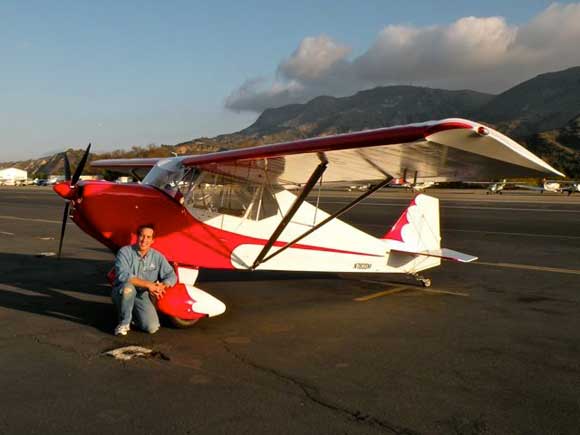
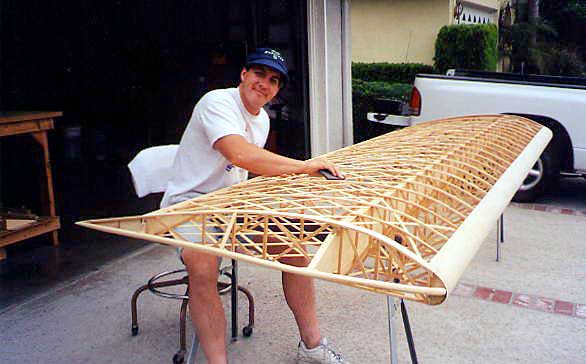
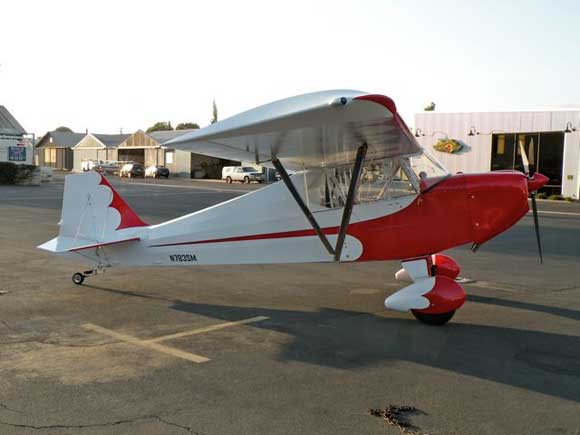 didn’t know that”, or “You’re kidding me!” But at the end of my sermon when I thought I surely must have a convert, she simply shook her head and stated, “You’d never get me up in that thing!”
didn’t know that”, or “You’re kidding me!” But at the end of my sermon when I thought I surely must have a convert, she simply shook her head and stated, “You’d never get me up in that thing!”